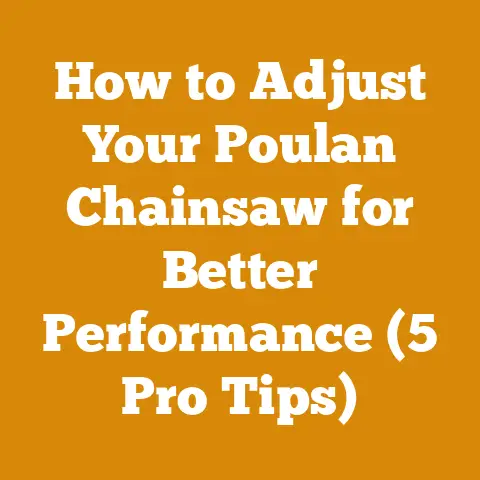Carpenter Ant Pile Control Tips (Pro Woodcare Secrets)
Understanding the Carpenter Ant Threat
Carpenter ants aren’t like termites; they don’t eat wood. Instead, they excavate it to create nests, hollowing out galleries and weakening the structure. This is where the problem-solution dynamic really comes into play. The problem is structural damage, and the solution is a combination of prevention, detection, and targeted treatment.
The Problem: Structural Damage
Carpenter ants can cause significant structural damage over time. They target damp, decaying wood, but they’ll also happily expand into sound, dry wood once a colony is established. This can lead to costly repairs and even compromise the safety of your home or workshop.
The Solution: Prevention, Detection, and Treatment
- Prevention: Eliminating moisture sources, sealing entry points, and using treated wood.
- Detection: Regularly inspecting wood structures for signs of infestation, such as sawdust piles or ant activity.
- Treatment: Applying insecticides directly to nests and using baits to eliminate the colony.
I’ve seen firsthand how a seemingly small carpenter ant problem can quickly escalate into a major headache. One of my early woodworking projects, a beautiful outdoor bench made from cedar, became a carpenter ant buffet after I neglected to properly seal it. The damage was extensive, and the experience taught me a valuable lesson about the importance of wood preservation.
Identifying Carpenter Ants and Their Damage
Before you can effectively control carpenter ants, you need to be able to identify them and recognize the signs of their activity.
What Do Carpenter Ants Look Like?
- Size: Carpenter ants are larger than most other ant species, typically ranging from 1/4 to 3/4 inch in length.
- Color: They can be black, red, or a combination of both.
- Shape: They have a smooth, evenly rounded thorax (the section between the head and abdomen).
- Antennae: Elbowed antennae.
Signs of Carpenter Ant Infestation
- Sawdust Piles (Frass): Carpenter ants don’t eat wood, so they leave behind piles of coarse sawdust near their nests. This “frass” often contains insect parts and debris. I’ve found that the appearance of this frass is a key indicator. If it’s mixed with dead ants and other debris, the infestation is likely active.
- Ant Activity: Seeing carpenter ants crawling around, especially indoors, is a clear sign of infestation. They are most active at night.
- Hollow Sounds: Tapping on wood that sounds hollow may indicate carpenter ant damage.
- Visible Galleries: In severe infestations, you may be able to see the galleries that carpenter ants have created within the wood.
Data Point: A study by the USDA Forest Service found that carpenter ant infestations are more common in areas with high humidity and rainfall. In these areas, preventative measures are especially important.
Prevention: The First Line of Defense
The best way to deal with carpenter ants is to prevent them from infesting your wood in the first place. This involves a multi-pronged approach that addresses their basic needs: food, water, and shelter.
Eliminating Moisture Sources
Carpenter ants are attracted to damp wood, so eliminating moisture sources is crucial.
- Repair Leaks: Fix any leaks in your roof, plumbing, or foundation.
- Improve Drainage: Ensure that water drains away from your home’s foundation.
- Ventilate Crawl Spaces: Proper ventilation will help to reduce moisture buildup in crawl spaces.
- Clear Gutters: Keep your gutters clean and free of debris to prevent water from overflowing and damaging wood.
Sealing Entry Points
Carpenter ants can enter your home through even the smallest cracks and crevices.
- Caulk Cracks: Seal any cracks or gaps in your foundation, around windows and doors, and where pipes enter your home.
- Weatherstrip Doors and Windows: Install weatherstripping to create a tight seal.
- Screen Vents: Cover vents with fine-mesh screens to prevent ants from entering.
Using Treated Wood
When building or repairing wood structures, use pressure-treated wood or wood treated with borate preservatives.
- Pressure-Treated Wood: This type of wood is infused with chemicals that make it resistant to insects and decay. It’s ideal for outdoor applications, such as decks and fences.
- Borate Preservatives: Borates are a natural mineral salt that is toxic to insects but relatively safe for humans and pets. They can be applied to wood as a liquid or powder.
Data Point: Pressure-treated wood has a lifespan of 20-40 years or more, compared to untreated wood, which may only last a few years in damp conditions. This makes it a worthwhile investment for long-term protection against carpenter ants and other wood-destroying organisms.
Removing Food Sources
Carpenter ants are attracted to sugary substances and other food sources.
- Store Food Properly: Keep food in airtight containers to prevent ants from accessing it.
- Clean Up Spills: Immediately clean up any spills or crumbs.
- Trim Trees and Shrubs: Keep trees and shrubs trimmed back from your home to prevent ants from using them as a bridge to your house.
- Remove Stumps and Dead Wood: Remove any tree stumps or dead wood from your property, as these can provide nesting sites for carpenter ants.
I once had a client who couldn’t figure out why carpenter ants kept returning to their deck, even after multiple treatments. It turned out they were feeding on the sugary residue from spilled drinks that had seeped into the wood. A thorough cleaning and sealing of the deck solved the problem.
Detection: Finding the Enemy
Even with the best preventative measures, carpenter ants can still find their way into your wood. Regular inspections are essential for detecting infestations early, before they cause significant damage.
Regular Inspections
- Inspect Wood Structures: Regularly inspect wood structures, such as decks, fences, and siding, for signs of carpenter ant activity.
- Pay Attention to Damp Areas: Focus on areas that are prone to moisture, such as around windows, doors, and plumbing.
- Check for Sawdust: Look for piles of sawdust near wood structures.
- Listen for Hollow Sounds: Tap on wood to check for hollow sounds.
- Nighttime Observations: Carpenter ants are most active at night, so inspect your property after dark with a flashlight.
Tools for Detection
- Screwdriver or Awl: Use a screwdriver or awl to probe wood for soft spots or hollow areas.
- Moisture Meter: A moisture meter can help you identify areas with high moisture content, which are more attractive to carpenter ants.
- Borescope: A borescope is a small camera that can be inserted into small holes to inspect hidden areas.
Case Study: I was called to inspect a home with suspected carpenter ant damage. The homeowner hadn’t noticed any signs of infestation, but they had heard strange noises coming from a wall. Using a borescope, I was able to locate a large carpenter ant nest inside the wall cavity. The nest was located near a leaky pipe, which had created the perfect environment for the ants. The homeowner was able to address the leak and treat the infestation before it caused significant damage.
Technical Requirements: A moisture meter should read below 15% for wood to be considered dry enough to resist carpenter ant infestation. Pressurized wood needs to meet American Wood Protection Association (AWPA) standards for preservative retention.
Treatment: Eliminating the Colony
If you find evidence of carpenter ant infestation, it’s important to take action to eliminate the colony. There are several treatment options available, including insecticides, baits, and professional pest control services.
Insecticides
Insecticides can be used to kill carpenter ants directly. They are available in a variety of formulations, including sprays, dusts, and foams.
- Sprays: Sprays can be used to treat exposed wood surfaces and to create a barrier around your home.
- Dusts: Dusts can be applied to cracks and crevices where carpenter ants are likely to travel.
- Foams: Foams can be injected into wall voids and other hard-to-reach areas.
Important Note: When using insecticides, always follow the manufacturer’s instructions carefully. Wear protective clothing, such as gloves and a mask, and keep children and pets away from treated areas.
Baits
Baits contain a slow-acting insecticide that carpenter ants carry back to the nest, eventually killing the entire colony.
- Liquid Baits: Liquid baits are placed in bait stations that carpenter ants can access.
- Granular Baits: Granular baits are scattered around the perimeter of your home.
Data Point: A study published in the Journal of Economic Entomology found that baits are more effective than sprays for controlling carpenter ant infestations, as they target the entire colony, not just the individual ants that are exposed to the spray.
Professional Pest Control Services
If you have a severe carpenter ant infestation, or if you are uncomfortable using insecticides yourself, it’s best to hire a professional pest control service.
- Experience and Expertise: Pest control professionals have the experience and expertise to identify and treat carpenter ant infestations effectively.
- Specialized Equipment: They have access to specialized equipment, such as high-pressure injectors, that can reach nests in hard-to-reach areas.
- Warranty: Many pest control companies offer warranties on their services, which can provide peace of mind.
DIY Treatment Strategies That Worked For Me
Over the years, I’ve experimented with a few DIY treatment methods that have proven surprisingly effective in certain situations.
- Boric Acid and Sugar Water Bait: Mix boric acid with sugar water to create a bait that attracts carpenter ants. Place the bait in shallow containers near areas where you’ve seen ant activity. The sugar attracts the ants, and the boric acid slowly poisons them. Important Note: Keep out of reach of children and pets.
- Diatomaceous Earth (DE): This natural powder is made from fossilized diatoms and is harmless to humans and pets, but deadly to insects. Sprinkle DE around the perimeter of your home, in cracks and crevices, and near ant trails. The sharp edges of the DE cut through the ants’ exoskeletons, causing them to dehydrate and die. Use food-grade DE only.
- Vinegar Spray: A simple vinegar spray can be used to disrupt ant trails and deter them from entering your home. Mix equal parts vinegar and water in a spray bottle and spray it on surfaces where you’ve seen ant activity.
Technical Requirements: When using insecticides, follow label instructions precisely. The active ingredient should be listed for carpenter ant control. For baits, ensure they are placed in areas inaccessible to children and pets.
Long-Term Woodcare Secrets: Protecting Your Investment
Controlling carpenter ants is an ongoing process, not a one-time fix. To protect your wood from future infestations, it’s important to implement a long-term woodcare strategy.
Regular Maintenance
- Inspect Regularly: Continue to inspect your wood structures regularly for signs of carpenter ant activity.
- Repair Damage: Repair any damage promptly to prevent carpenter ants from exploiting weakened areas.
- Maintain Moisture Control: Continue to eliminate moisture sources and ensure proper ventilation.
- Reapply Treatments: Reapply insecticides or borate preservatives as needed, following the manufacturer’s instructions.
Wood Preservation Techniques
- Seal Wood: Seal wood surfaces with a high-quality sealant to protect them from moisture and insect damage.
- Apply Wood Preservatives: Apply wood preservatives to protect wood from decay and insect attack.
- Consider Wood Alternatives: Consider using wood alternatives, such as composite decking or fiber cement siding, for areas that are prone to moisture or insect damage.
Data Point: A study by the Forest Products Laboratory found that wood treated with preservatives can last up to 10 times longer than untreated wood.
Sustainable Woodcare Practices
- Use Natural Products: Choose natural woodcare products that are less harmful to the environment and your health.
- Recycle Wood: Recycle wood whenever possible to reduce the demand for new wood and conserve forest resources.
- Support Sustainable Forestry: Support sustainable forestry practices by purchasing wood products that are certified by the Forest Stewardship Council (FSC).
Firewood Management and Storage
Firewood can be a prime target for carpenter ants. Proper storage is crucial.
- Stack Firewood Off the Ground: Elevate firewood on a rack or pallets to prevent it from coming into contact with the ground.
- Store Firewood Away from Your Home: Store firewood at least 20 feet away from your home to prevent ants from migrating into your house.
- Cover Firewood: Cover firewood with a tarp to protect it from rain and snow.
- Use Firewood Within One Year: Use firewood within one year to prevent it from becoming infested with insects or decay.
- Inspect Firewood Before Bringing It Indoors: Inspect firewood for signs of carpenter ants or other insects before bringing it indoors.
Technical Requirements: Firewood should have a moisture content below 20% for optimal burning and to minimize the risk of insect infestation. Stacking wood in a single row allows for better airflow and faster drying.
My Personal Firewood Story
I once made the mistake of stacking firewood directly against my house. Big mistake! Within a few months, I noticed carpenter ants crawling all over the siding. It took a lot of effort to get rid of the ants and repair the damage. Now, I always stack my firewood on a rack, away from the house, and covered with a tarp. It’s a small effort that makes a big difference.
Addressing Specific Wood Types
Different types of wood have varying levels of resistance to carpenter ants. Understanding the properties of different woods can help you make informed decisions about wood selection and preservation.
Hardwoods vs. Softwoods
- Hardwoods: Hardwoods, such as oak, maple, and cherry, are generally more resistant to carpenter ants than softwoods. This is because they are denser and have a tighter grain, making it more difficult for ants to excavate.
- Softwoods: Softwoods, such as pine, fir, and cedar, are more susceptible to carpenter ant damage. They are less dense and have a looser grain, making it easier for ants to excavate.
Naturally Resistant Woods
Some woods are naturally resistant to carpenter ants due to their chemical composition.
- Cedar: Cedar contains natural oils that are toxic to insects. It’s a popular choice for outdoor applications, such as decks and fences.
- Redwood: Redwood also contains natural oils that are resistant to insects and decay. It’s a good choice for outdoor structures that are exposed to moisture.
- Osage Orange: Osage orange is a very dense and durable wood that is highly resistant to insects and decay. It’s often used for fence posts and other outdoor applications.
Technical Specifications: The Janka hardness scale measures the resistance of wood to indentation. Woods with a higher Janka rating are generally more resistant to carpenter ants. For example, Osage Orange has a Janka rating of over 2000 lb-force, while Eastern White Pine has a rating of only 380 lb-force.
Protecting Softwoods
If you are using softwoods for your projects, it’s important to take extra precautions to protect them from carpenter ants.
- Use Pressure-Treated Wood: Pressure-treated softwood is highly resistant to insects and decay.
- Apply Borate Preservatives: Borate preservatives can be applied to softwood to make it less attractive to carpenter ants.
- Seal Wood: Seal softwood surfaces with a high-quality sealant to protect them from moisture and insect damage.
Tool Calibration and Maintenance: Ensuring Effective Woodcare
The tools you use for woodcare are just as important as the techniques you employ. Properly calibrated and maintained tools will help you apply treatments effectively and prevent further damage.
Sprayers and Applicators
- Calibrate Sprayers: Calibrate sprayers to ensure that you are applying the correct amount of insecticide or preservative.
- Clean Sprayers Regularly: Clean sprayers regularly to prevent clogs and ensure proper function.
- Replace Nozzles: Replace worn or damaged nozzles to maintain a consistent spray pattern.
Drills and Screwdrivers
- Use Sharp Drill Bits: Use sharp drill bits to create clean, precise holes for injecting insecticides or preservatives.
- Select the Right Screws: Select the right screws for the job to ensure that they hold securely and don’t damage the wood.
- Maintain Drill and Screwdriver Bits: Keep drill and screwdriver bits clean and sharp for optimal performance.
Moisture Meters
- Calibrate Moisture Meters Regularly: Calibrate moisture meters regularly to ensure accurate readings.
- Store Moisture Meters Properly: Store moisture meters in a dry place to prevent damage.
- Replace Batteries: Replace batteries regularly to ensure accurate readings.
Safety Equipment
- Wear Protective Clothing: Wear protective clothing, such as gloves, a mask, and eye protection, when using insecticides or preservatives.
- Use Respirators: Use respirators when working in enclosed spaces or when applying chemicals that may be harmful to breathe.
- Follow Safety Guidelines: Follow all safety guidelines provided by the manufacturer of the products you are using.
Technical Requirements: Sprayers should be calibrated to deliver a specific volume of liquid per unit area (e.g., ounces per square foot). Moisture meters should be calibrated using a calibration block or a known moisture standard. Respirators should be NIOSH-approved and fitted properly.
Legal and Ethical Considerations
When dealing with carpenter ants, it’s important to be aware of the legal and ethical considerations involved.
Pesticide Regulations
- Follow Label Instructions: Always follow the label instructions when using pesticides.
- Use Registered Pesticides: Use only pesticides that are registered for use in your area.
- Obtain Necessary Permits: Obtain any necessary permits before applying pesticides.
Environmental Concerns
- Minimize Pesticide Use: Minimize pesticide use by using preventative measures and targeting treatments.
- Protect Water Sources: Protect water sources from pesticide contamination.
- Dispose of Pesticides Properly: Dispose of pesticides properly according to local regulations.
Ethical Considerations
- Inform Neighbors: Inform your neighbors if you are using pesticides that may affect them.
- Protect Non-Target Organisms: Take steps to protect non-target organisms, such as beneficial insects and pollinators.
- Consider Alternative Treatments: Consider alternative treatments, such as baits or natural products, before resorting to pesticides.
Data Point: Many states have regulations regarding the use of pesticides near schools, hospitals, and other sensitive areas. It’s important to be aware of these regulations and to comply with them.
Conclusion: A Proactive Approach to Woodcare
Carpenter ants are a persistent threat to wood structures, but with a proactive and informed approach, you can protect your investment and prevent costly damage. By understanding their behavior, implementing preventative measures, detecting infestations early, and using effective treatment strategies, you can keep your wood safe from these destructive insects. Remember, long-term woodcare is an ongoing process that requires vigilance and attention to detail.






